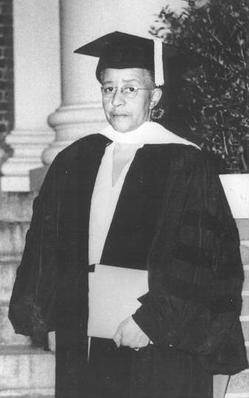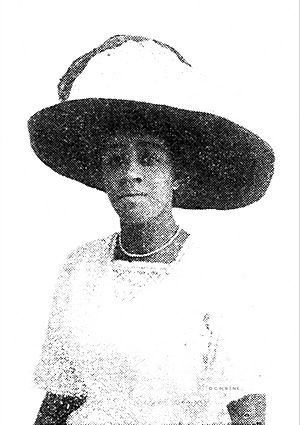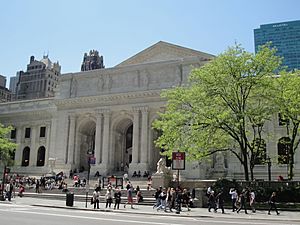Sadie Peterson Delaney facts for kids
Quick facts for kids
Sadie Peterson Delaney
|
|
|---|---|
 |
|
| Born | February 26, 1889 Rochester, New York |
| Died | May 4, 1958 (aged 69) Tuskegee, Alabama |
| Occupation | Librarian |
| Nationality | American |
Sadie Peterson Delaney (born February 26, 1889 – died May 4, 1958) was a very important librarian. She worked for 34 years as the main librarian at the Veterans Administration Hospital in Tuskegee, Alabama. Sadie is famous for being a pioneer in a special way of helping people called bibliotherapy.
Contents
Sadie's Early Life
Sadie Peterson Delaney was born in Rochester, New York, on February 26, 1889. Her parents were Julia Frances Hawkins Johnson and James Johnson. She grew up and went to high school in Poughkeepsie, New York.
Sadie was very active in her church, the Smith Metropolitan AME Zion Church. She taught Sunday School and was part of a sewing group. She was also known for her poetry and led a literary society.
She went to college at the College of the City of New York and finished in 1919. Then, she studied to become a librarian at the New York Public Library School from 1920 to 1921. Sadie had one daughter, Grace, with her first husband, Edward Louis Peterson. Later, she married Rudicel A. Delaney in 1928. Sadie passed away in Tuskegee, Alabama, on May 4, 1958, after a heart attack.
Her Amazing Career
Working at the New York Public Library
After her training, Sadie continued to work at the New York Public Library. She was at the 135th Street Branch in Harlem until 1923. She worked very hard to create more programs for children from different backgrounds.
She organized story times, discussion groups, and other fun events for kids. Some of these events were just for children who had trouble, or for children who were new to the country, or for blind children. Because she cared about blind children, she learned Braille and Moon Code. These are special ways for blind people to read and write. She also helped parents and community leaders understand how important the library was for children.
While at the New York Public Library, Sadie helped create a special collection of books by and about African Americans. She often met with African American authors. She helped them connect with other writers and publishers. Sadie also set up artistic programs. These included talks by famous people like W. E. B. Du Bois, James Weldon Johnson, and others. She even started the first art show featuring African American art at the New York Public Library.
Helping Veterans in Tuskegee
Sadie was asked to lead the library at the Veterans Administration Hospital in Tuskegee, Alabama. This hospital cared for African American war veterans. Some had physical injuries, and others had mental or emotional challenges. Sadie first took a six-month break from the New York Public Library. But she loved her work in Tuskegee so much that she stayed there for the rest of her career.
When she arrived in January 1924, the hospital library was very small. It only had 200 books and one table. Sadie's first step was to make the library a more welcoming place. She moved it to a bigger room. She added plants, flowers, and decorations to make it feel warm and inviting. She wanted the library to have a positive effect on the patients. She also started getting many more books for both the patients and the medical staff.
Within just one year, the library had grown a lot. It had 4,000 books for patients and 85 books for the medical library. People were borrowing 1,000 books every month! By 1954, there were over 13,000 books for patients and over 3,000 for the medical staff. Sadie worked there for 34 years until she passed away in 1958.
What is Bibliotherapy?
Sadie used bibliotherapy a lot in her work. She said it was "the treatment of patients through selected reading." This means using books to help people feel better. She believed in giving patients special attention to learn what they liked. This helped her choose books that would really interest them.
To pick the right books, Sadie talked with doctors and medical staff. She thought it was very important for librarians to be part of medical meetings about patients. She also reviewed books, especially those by or about African Americans. When choosing books for the library, she always thought about what patients would enjoy. She also made sure to have books about current events and for research.
To go along with bibliotherapy, Sadie created many special programs. She started book talks, monthly meetings, and story hours. She also created different clubs. She shared her own interests in some groups, like the stamp and coin collecting clubs. She worked hard to get all the veterans involved in library activities.
She had a special book cart program. This meant patients who couldn't leave their beds could still get books. For those who couldn't hold a book, Sadie found a way to project the book onto the wall. Patients could turn the pages with just one button. She also sang familiar songs and read poetry to help patients relax.
Sadie continued teaching Braille to blind patients at the hospital. As they learned, some patients even taught others. She also got talking books for blind patients. Sadie taught over 600 patients how to read Braille! They were also encouraged to join clubs and programs, just like other patients.
In 1927, Sadie and the patients started sharing their library activities on the local radio station. Patients took part in book and art fairs. They showed their work and gave talks about books. Sadie gave them many chances to be creative. She also started the Disabled Veterans’ Literary Society. This group was praised by the Veterans Administration. In 1938, Sadie wrote in Opportunity magazine about her work. She said, "Here minds long imprisoned by lethargy are awakened...And once again he is alive with enthusiasm and joy derived from activity."
Professional Groups
Sadie was part of many important professional groups. She was on the advisory board for the NAACP for five years. She was also a member of the International Library Association and the American Library Association (ALA). She served on the ALA Council from 1946 to 1951. In 1947, she was chosen to be a councilor for the ALA Hospital Library Division. She also worked on the Library of Congress Committee for Work with the Blind.
Sadie tried to join the Alabama Library Association. At that time, they did not allow African Americans to be members. The president of the Alabama Library Association invited her to join. But when the next president took over in 1951, her membership was stopped. They suggested she start a separate African American group. Sadie did not agree with this idea. She pointed out that other professional groups, even in southern states, had become integrated. Sadie tried to join again two years later, but she was still rejected.
Awards and Special Recognitions
Students from universities like University of Illinois, University of North Carolina, and Atlanta University came to learn from Sadie. Librarians from Europe, South Africa, and all over the United States also visited to see her work with bibliotherapy. Her library became a model for other Veterans Administration hospitals. She was invited to give speeches at American universities, churches, and a conference in Rome in 1934.
In 1948, the Iota Phi Lambda sorority named her Woman of the Year. She received this honor again in 1949 from the Zeta Phi Beta sorority. Then, in 1950, the National Urban League also gave her this award. Also in 1950, Atlanta University gave her an honorary doctorate. She was honored at a special dinner at the 1950 American Library Association convention. In 1956, the US Veterans Administration gave her their highest award for excellence.
Her Lasting Impact
- After Sadie passed away in 1958, the Atlanta University School of Library Science started a scholarship in her name.
- Sadie was added to the Alabama Library Association's Hall of Fame in 1982.
- A library in Poughkeepsie, New York, was named in her honor: The Sadie Peterson Delaney African Roots Library.
- On April 9, 2022, The Sadie Peterson Delaney African Roots Branch Library reopened. It is now a full library that honors Sadie's work to help people read and learn.
- The New York Public Library has collected and saved many of Sadie's personal letters.
- American Libraries magazine recognized Sadie as one of the 100 most important leaders of the 20th century.
- In 2015, a non-profit group called Words Heal, Inc. was also named the Sadie Peterson Delaney Literary Collaborative. This group helps people by promoting bibliotherapy as a way to support mental wellness.



